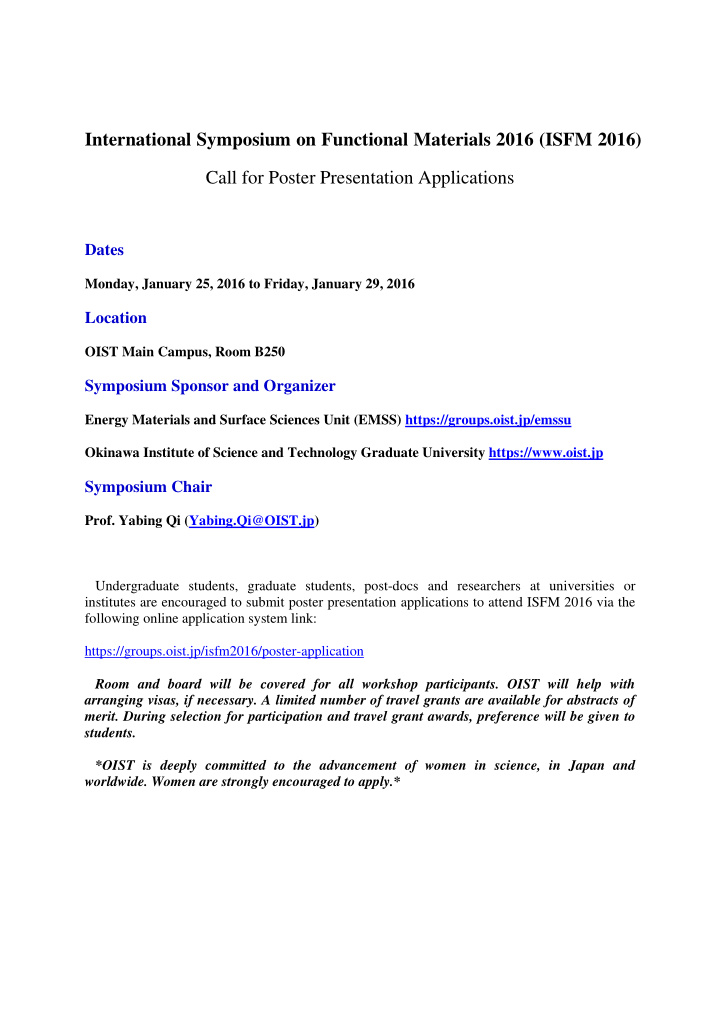



International Symposium on Functional Materials 2016 (ISFM 2016) Call for Poster Presentation Applications Dates Monday, January 25, 2016 to Friday, January 29, 2016 Location OIST Main Campus, Room B250 Symposium Sponsor and Organizer Energy Materials and Surface Sciences Unit (EMSS) https://groups.oist.jp/emssu Okinawa Institute of Science and Technology Graduate University https://www.oist.jp Symposium Chair Prof. Yabing Qi (Yabing.Qi@OIST.jp) Undergraduate students, graduate students, post-docs and researchers at universities or institutes are encouraged to submit poster presentation applications to attend ISFM 2016 via the following online application system link: https://groups.oist.jp/isfm2016/poster-application Room and board will be covered for all workshop participants. OIST will help with arranging visas, if necessary. A limited number of travel grants are available for abstracts of merit. During selection for participation and travel grant awards, preference will be given to students. *OIST is deeply committed to the advancement of women in science, in Japan and worldwide. Women are strongly encouraged to apply.*
Confirmed Speakers Michael Graetzel: Professor and Director, Laboratory of Photonics and Interfaces, Ecole Polytechnique Federale de Lausanne, Switzerland Antoine Kahn: Professor and Associate Chair, Department of Electrical Engineering, Princeton University, USA Jean Luc Bredas: Distinguished Professor and Director, KAUST, Saudi Arabia Takao Someya: Professor, University of Tokyo, Japan Eiichi Nakamura: Professor, University of Tokyo, Japan Zhenan Bao: Professor, Stanford University, USA Miquel Salmeron: Senior Staff Scientist, Lawrence Berkeley National Laboratory and Adjunct Professor, UC Berkeley, USA Flemming Besenbacher: Professor, iNano and Aarhus University, Denmark Chihaya Adachi: Professor and Director of the Center for Organic Photonics and Electronics Research, Kyushu University, Japan Wei Huang: Chair Professor and President (Academician), NanJing Tech University, China David Cahen: Professor and The Rowland and Sylvia Schaefer Chair in Energy Research, Weizmann Institute of Science, Israel Shuit-Tong Lee: Professor and Director (Academician), Soochow University, China Kazuo Takimiya: Group Director, Emergent Molecular Function Research Group, RIKEN, Japan Lei Jiang: Professor and Academician, The Institute of Chemistry, Chinese Academy of Sciences, China Tsutomu Miyasaka: Professor, Toin University of Yokohama, Japan Nam-Gyu Park: Professor, Sungkyunkwan University, Korea Yang Yang: The Carol and Lawrence E. Tannas Jr. Endowed Chair in Engineering, UCLA, USA Jun Takeya: Professor, University of Tokyo, Japan Antonio Facchetti: Chief Technology Officer, Polyera and Adjunct Professor, Northwestern University, USA Sang Il Seok: Professor, Korea Research Institute of Chemical Technology, Korea Henning Sirringhaus: Hitachi Professor of Electron Device Physics, University of Cambridge, UK Norbert Koch, Professor and Chair, Humboldt-Universität zu Berlin, Germany Katsuhiko Ariga, MANA Principal Investigator, NIMS, Japan Juan Bisquert: Professor, Universitat Jaume I de Castelló, Spain Jeffrey Neaton: Professor, UC Berkeley and Director, The Molecular Foundry, Lawrence Berkeley National Laboratory, USA Jeong Young Park: Associate Professor, Korea Advanced Institute of Science and Technology, Korea Yutaka Ie: Associate Professor, Osaka University, Japan Mukhles Sowwan: Associate Professor, Nanoparticles by Design Unit, OIST, Japan Keshav Dani, Assistant Professor, Femtosecond Spectroscopy Unit, OIST, Japan Matthias Wolf: Assistant Professor, Molecular Cryo-Electron Microscopy Unit, OIST, Japan
The aim of this symposium is to bring together leading experts and aspiring scientists to report and discuss the latest progress in functional materials as well as instrumentation development for studying these materials. Information exchange and research collaboration will be promoted through stimulating results and engaging discussion, discussion panels, video poster sessions, and mixer events of symposium participants and OIST graduate students, and other flexible interactions. Hot topics will include: organic-inorganic hybrid materials like perovskites, organic energy materials, and scanning-tunneling spectroscopy of functional molecules. Advances in photovoltaics in the past years with multiple world records over 10% efficiency have been made possible through new functional materials, e.g. organic-inorganic hybrids like perovskites, high performance semiconducting polymers, and small molecules. Perovskites in particular will be highlighted by multiple speakers; perovskite materials are proving them to be capable of power conversions efficiencies of over 20%. Advanced instrumentation are key to the understanding of the properties and interactions of these new materials, which is critical to optimizing their performance, improving their stability, and developing new materials and device structures to capitalize on these advances. The symposium will emphasize the topics such as, but not limited to: Fundamentals and applications of perovskites Rational design and synthesis of functional materials Cutting-edge techniques and instrumentation for functional materials investigation Air exposure effects, photo-oxidation and lifetime of solar cells Plasmonic effects in solar cells Thin film deposition and analysis Nanostructured thin films Oxide films for solar cell applications Influence of interface structure and orientation on electronics based on functional materials Electronic and optical properties of hybrid materials Organic thin film transistors, organic solar cells, and organic light emitting diodes Organic/organic, organic/metal, organic/oxide interfaces Electroluminescence Morphology control and optimization of thin films of functional materials Charge transport in crystalline semiconductors Electrical properties and energetics of semiconducting polymers and small molecules
Recommend
More recommend